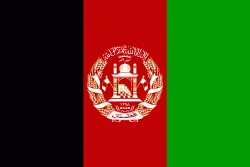Mazar-i-Sharif (Mazār-e Sharīf)
Mazār-i-Sharīf (Dari/مزارشریف ; ), also called Mazār-e Sharīf, or just Mazār, is the fourth-largest city of Afghanistan, with a population estimate of 1,000,000 people. It is the capital of Balkh province and is linked by highways with Kunduz in the east, Kabul in the southeast, Herat in the southwest and Termez, Uzbekistan in the north. It is about 55 km from the Uzbek border. The city is also a tourist attraction because of its famous shrines as well as the Islamic and Hellenistic archeological sites. The ancient city of Balkh is also nearby.
The region around Mazar-i-Sharif has been historically part of Greater Khorasan and was controlled by the Tahirids followed by the Saffarids, Samanids, Ghaznavids, Ghurids, Ilkhanates, Timurids, and Khanate of Bukhara until 1751 when it became part of the Durrani Empire (although under autonomous emirs). Eventually the city passed to a few local rulers before becoming part of Afghanistan in 1849.
Mazar-i-Sharif is the regional hub of northern Afghanistan, located in close proximity to both Uzbekistan and Tajikistan. It is also home to an international airport. It has the highest percentage of built-up land (91%) of all the Afghan provincial capitals, and it has additional built-up area extending beyond the municipal boundary but forming a part of the larger urban area. It is also the lowest-lying major city in the country, about 357 m above sea level. The city was spared the devastation that occurred in the country's other large cities during the Soviet–Afghan War and subsequent civil war, and was long regarded as one of the safest cities in the country.
On 14 August 2021, Mazar-i-Sharif was seized by Taliban fighters, becoming the twenty-fifth provincial capital to be captured by the Taliban as part of the wider 2021 Taliban offensive.
The name Mazar-i-Sharif means "tomb of the saint", a reference to the tomb of Hazrat Ali ibn Abi Talib, cousin, son-in-law and companion of the Islamic prophet Muhammad. The tomb is housed in the large, blue-tiled sanctuary and mosque in the center of the city known as the Shrine of Ali or the Blue Mosque.
The region around Mazar-i-Sharif has been historically part of Greater Khorasan and was controlled by the Tahirids followed by the Saffarids, Samanids, Ghaznavids, Ghurids, Ilkhanates, Timurids, and Khanate of Bukhara until 1751 when it became part of the Durrani Empire (although under autonomous emirs). Eventually the city passed to a few local rulers before becoming part of Afghanistan in 1849.
Mazar-i-Sharif is the regional hub of northern Afghanistan, located in close proximity to both Uzbekistan and Tajikistan. It is also home to an international airport. It has the highest percentage of built-up land (91%) of all the Afghan provincial capitals, and it has additional built-up area extending beyond the municipal boundary but forming a part of the larger urban area. It is also the lowest-lying major city in the country, about 357 m above sea level. The city was spared the devastation that occurred in the country's other large cities during the Soviet–Afghan War and subsequent civil war, and was long regarded as one of the safest cities in the country.
On 14 August 2021, Mazar-i-Sharif was seized by Taliban fighters, becoming the twenty-fifth provincial capital to be captured by the Taliban as part of the wider 2021 Taliban offensive.
The name Mazar-i-Sharif means "tomb of the saint", a reference to the tomb of Hazrat Ali ibn Abi Talib, cousin, son-in-law and companion of the Islamic prophet Muhammad. The tomb is housed in the large, blue-tiled sanctuary and mosque in the center of the city known as the Shrine of Ali or the Blue Mosque.
Map - Mazar-i-Sharif (Mazār-e Sharīf)
Map
Country - Afghanistan
 |
 |
| Flag of Afghanistan | |
Human habitation in Afghanistan dates back to the Middle Paleolithic era, and the country's strategic location along the historic Silk Road has led it to being described, picturesquely, as the ‘roundabout of the ancient world’. Popularly referred to as the graveyard of empires, the land has historically been home to various peoples and has witnessed numerous military campaigns, including those by the Persians, Alexander the Great, the Maurya Empire, Arab Muslims, the Mongols, the British, the Soviet Union, and most recently by a US-led coalition. Afghanistan also served as the source from which the Greco-Bactrians and the Mughals, amongst others, rose to form major empires. The various conquests and periods in both the Iranian and Indian cultural spheres made the area a center for Zoroastrianism, Buddhism, Hinduism, and later Islam throughout history.
Currency / Language
| ISO | Currency | Symbol | Significant figures |
|---|---|---|---|
| AFN | Afghan afghani | Ø‹ | 2 |
| ISO | Language |
|---|---|
| PS | Pashto language |
| FA | Persian language |
| TK | Turkmen language |
| UZ | Uzbek language |















